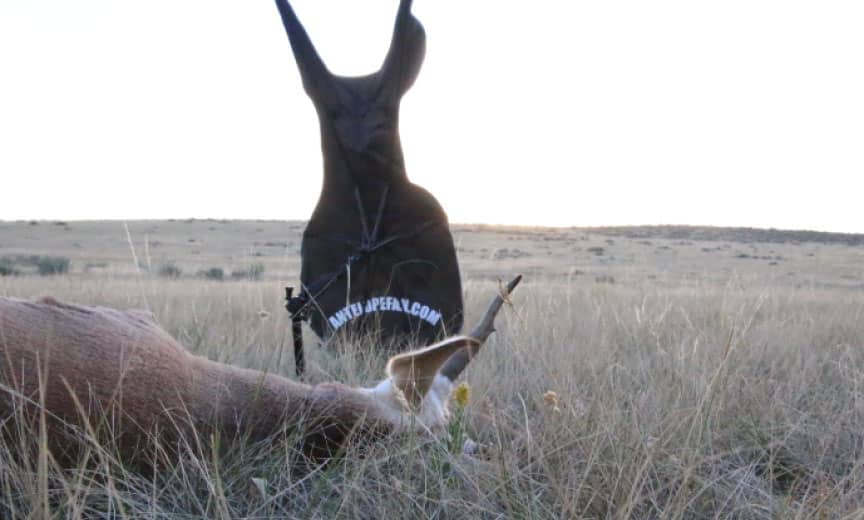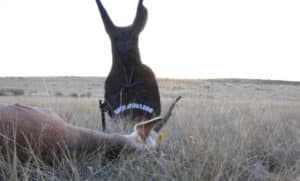Never having hunted speed goats before, we weren’t sure if our new antelope decoy we were testing was all wrong, or if it was us botching stalk after stalk.
For months, if not years prior. I read blogs, magazine articles, and books. I watched you tube videos, and hunting shows. Anything I could find to learn what made these prairie rockets tick.
Like most hunting, I learned there were many variables that would either trigger a charge or send them running for the hills. Some of these variables were weather, number of bucks vs does, hunting pressure, terrain, timing of the year, and of course the type of decoy being used.
Having put hundreds if not thousands of stalks on turkeys behind a decoy. We felt confident in our ability and knowledge to sneak with the decoy, and use the terrain in our benefit to get within that perfect distance before showing our selves. The only variable we felt we could not control was the time of year. Antelope like other game animals just aren’t going to respond how you want if its not that magic time of year “The Rut”.
All of our research told us for the area we were heading to that a few days either way of September 15th would be that magic time. Unfortunately for us our schedules didn’t allow that perfect timing. In fact we would be there almost 2 weeks early. So we crossed our fingers and hoped for the best.
We hit the ground running with plenty of goats around to chase. With every botched attempt we would learn another lesson. After a long day of stalk after stalk producing nothing but goats skirting around us as if they were teasing us, I made a few phone calls. I wanted to pick the brains of a few guys that had hunted these animals their whole lives. You see, from everything I had previously learned, what we saw that first day didn’t match up to any of it. The goats weren’t charging in aggressively nor were they tucking tail and heading for the hills at 60 mph. They would trot in but on the downwind side just out of bow range almost every time. Perhaps they wanted to fight, but weren’t quite warmed up for it yet and wanted to see whom they were dealing with before committing to a fight.
As I explained this to some veterans of the game, I was glad to hear that this wasn’t unusual behavior, but the behavior of dominant bucks during the pre rut. Even then the gentleman I spoke to were astonished by my claims that 9 out of 10 stocks had happened this way. In their experience only 10% or less would do anything but tuck tail and run. Or rather gather up the harem and run them all off. This was good news, knowing are technique as well as our decoy we were testing was working as well as it could be.
Knowing that we were actually having good success. Success with out getting shots off, meant we would just have to keep at it and hope one ventured close enough. Or we needed to get creative. So that’s what we did.
After putting some thought into it, and since there were three of us. We decided to have 1 man on the decoy like before, 1 man behind the camera from afar, and one man on the down wind side about 100 yards out flanking the decoy. The trick is for the guy flanking to stay hidden. Some scenarios allow this where as others have terrain or lack there of that this isn’t always an option. Lucky for us we had plenty of goats to choose from so we took the best situations we could find. As soon as the shooter or “guy flanking” was in position, the decoy guy would slowly approach the goat. As if it were written out of the speed goat handbook it played out exactly like we wanted it to time after time. In fact the decoy had the goats attention so much that the shooter could many times get away with about anything as the goats ran right in to bow range.
100 yards was the range that day. The shooter would flank the decoy downwind and range him at 100 yards. Nearly every time the goat would run in to within 30 yards or closer to the shooter, sometimes on the far side, sometimes on the near side. So next time you are planning an Antelope hunt and are racking your brain on what dates to go, because you don’t want to miss the rut. Keep this in mind. I now believe missing the rut, and hunting the pre rut using this technique may be more deadly than hunting the rut.
– Will Downard
Last modified: February 21, 2022




Will,
You misspelled Stalk. It is Stalk not Stock. Thanks for making a cool product.